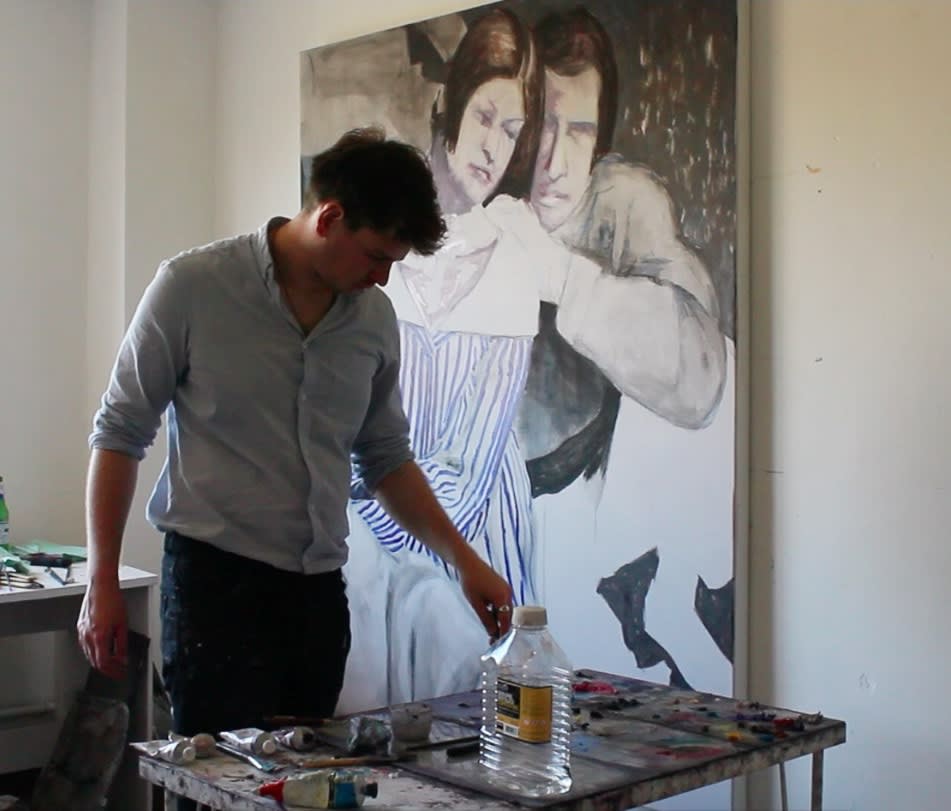
Tell us about your experience of 2020? Has the pandemic and subsequent lockdown changed the way you work or think about your practice?
No one could have predicted the pandemic, but by the start of 2020 there was a zeitgeist in art capturing a kind of looming sense of dread. The theme of catastrophe has always captured our imagination in popular media also, but it seems the apocalyptic film/series genre has reached a peak, predictably tracing the same story lines. When all of these things started to happen its not that it felt surreal, but more uncanny, like a film you have seen many times, the only difference being it had crossed a blurry line into the real.
A lot of people have had it very tough this year, and I am thankful that all I did was stay in my flat painting. I tried to make the make most of the time to reflect, although cabin fever did start to set in, I spent the time reading through old notebooks and making smaller scale paintings.
You often reference imagery found online, tell us a bit about your selection process?
I don’t discriminate where source images come from - they can be from news or social media, art history, screen shots from films, photos taken on my phone or sent to me, or real life. Sometimes I come across an image accidentally or it is specific to particular intent. I like how the historical and slow medium of paint can interrupt the way images flow though new information vectors like Instagram.
Since I moved to London a couple of years ago, I had been having vivid anxiety dreams, which I started writing down. They would always be about loss, forgetting something, and the feeling of being haunted by strange supernatural forces. I think the way I work with found images is in similar vein of the dreams, I’m drawn to things that are just outside of interpretation, that reveal something that is just below the surface. A lot of the references are metaphorical or symbolic. The themes often reflect an ambivalence of meaning; a breaking of usual linear narratives, where things slip between states, things like high/low culture, past and present, literal and duplicitous.
Your most recent painting ‘Lotus Tree’ has a slightly different feel to your more figurative works. Could you tell us a bit about that painting and any current developments in your practice.
With the Lotus Tree painting I wanted to develop from a Orange tree painting made last year. I was thinking about the relationship between the natural and artificial, the car air-freshener as a far-removed symbol of a tree, which hangs like fruit. In that way it is metaphorical of the semiotic blurring between real and simulated spaces. The title is from a fictional tree from the ancient Greek Homer’s Odyssey, where the fruit caused people to go into an unconscious daydream. The painting has thin a layer of thin muted paint, where the leaves look skeletal or barely there. This is contrasted with a quite direct thicker layer of the greens and yellow that sits on the surface. The intent for me is to create a similar relationship between the illusion of a space within a painting, and the physical reality of the paint. Its something I really enjoy in painting, playing with those sorts of formal contrasts, and the quite seductive qualities of tactile painting.
The history of painting is clearly a huge influence on your work. If you could go to the pub with anyone (in history) who would it be? What would you talk about?
It would be funny to go drinking with Francis Bacon. I think it be dark, drunk and serious, post-war existential talk, and painting. I admit that I am not that keen on his work now, but his methodology has been very influential for me. He represents a kind of access point into painting that I’m not sure I would have had otherwise.
What exhibitions are you looking forward to, or what were you disappointed to miss out on seeing in 2020 due to the lockdown?
I haven’t seen Lynette Yiadom-Boakye’s show at Tate Britain and am looking forward to it when it re-opens.
Do you have any artistic regrets?
When I started painting, I hadn’t studied art and was quite naïve. I didn’t come from an artistic background and the only way for me to learn was to keep trying things out. I’ve made a lot of false steps as I’ve gone on. I have since done an undergrad and postgrad degree in art, but I still feel I have the same naïve approach to art and the art world. There are things I look back and cringe at, but on the whole it’s a net good, so I try to take it with humility and keep going.
What does 2021 look like for you?
I have a new studio that is a short walk from my home in Brixton. Its nice to have a routine of walking in everyday, and having a better space than my living room. I’m working towards a solo show in October that I am really excited about. It is my second solo show with bo.lee gallery and first since leaving RCA.